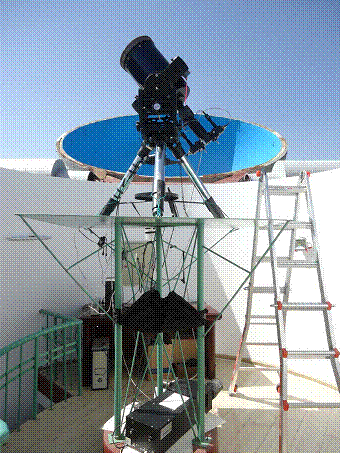On 24th July, the construction of the technology demonstrator for the Fibre Array Solar Optical Telescope (FASOT), an instrument planned by Yunnan Observatories, has been completed at the Phoenix Mountain headquarters. Colleagues working in the field of Solar Astrophysics have flocked to the site to inspect the new instrument, hailing from a multitude of institutions including, but not limited to, the Funding Committee of the National Natural Science Foundation, the National Astronomical Observatory of China (NAOC), Nanjing University (NJU), Purple Mountain Observatory (PMO), Shandong University, and the Kunming University of Science and Technology. Famed solar astrophysicist Academician Chen Fang functioned in the capacity of head of the inspection committee throughout the inspection procedure.
FASOT was initially proposed by a group headed by Zhongquan Qu, one of the Professors at Yunnan Observatories, and is based on their visions of a revolutionary telescope combining polarimeters with integral field unit technology. The instrument, once complete, will reveal precise information regarding how matter and energy (especially magnetic field energy) are transported from the bottom of the sun’s photosphere to the top of the chromosphere. Using the telescope’s high temporal resolution and high polarimetry precision, we will be able to observe small-timescale physical processes in the solar atmosphere, and also to understand solar eruptions and assess their implications on our immediate space surroundings.
The project has already won international acclaim. Solar astrophysicist J.O. Stenflo says of the FASOT project: “FASOT is technologically pioneering, since … This may open the door to a new class of telescope facilities in solar physics”. The project has also received support from 2 domestic funding agencies, the Funding Committee of the National Natural Science Foundation, and the Integrated Astronomical Research Fund.

The significance of the construction of the technology demonstrator are as follows:
1. it has shown that it is possible to conduct individual polarimetry on different spectral features simultaneously;
2. it has shown that the technology required to trigger polarimetry with integral field units is in place.
The former has never been achieved before by any instrument, domestic or otherwise. The latter is expected to improve the precision of our polarimetry, thereby improving our capabilities for detecting weak magnetic field distributed across the solar atmosphere.
Collaborators on the FASOT project include colleagues from Durham University and Nanjing University. Among the most notable contributors to the project are Drs. Jeremy Allington-Smith and Graham Murray for designing and building the integral field unit, Liang Chang for designing the optical system, Xiangming Cheng for designing the mechanical systems, Linhua Deng for heading the team that designed and built the electronic control system for the polarimetry, and Zhongquan Qu and Guangtao Dun for designing the on/off switch for the polarimeter. Guangtao Dun was also responsible for the initial assessment of the technology demonstrator.
On the subject of the FASOT project and the technology demonstrator which the project has to show so far, the inspection committee has commented as below:
The FASOT technology demonstrator is a vital asset in terms of assessing whether the various technologies crucial to the construction of FASOT are mature. The demonstrator has been built according to plan, and accomplished the following missions.
1. Polarimetry of multiple solar emission lines between 513 to 531 nanometers at a resolution of 5x5.
2. The combination of polarimeters and IFUs, as well as the enhancement of polarimeter spatial resolution.
3. Demonstration of the above capabilities in the context of a new instrument.
The committee has unanimously agreed that development should continue, and encourages the team to complete the instrument as soon as possible.